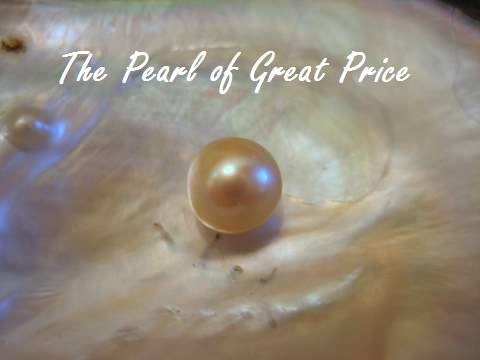[44] The kingdom of heaven is like unto a treasure hidden in a field. Which a man having found, hid it, and for joy thereof goeth, and selleth all that he hath, and buyeth that field.
[45] Again the kingdom of heaven is like to a merchant seeking good pearls. [46] Who when he had found one pearl of great price, went his way, and sold all that he had, and bought it.
[47] Again the kingdom of heaven is like to a net cast into the sea, and gathering together of all kind of fishes. [48] Which, when it was filled, they drew out, and sitting by the shore, they chose out the good into vessels, but the bad they cast forth.

Image taken from https://theslumberingbride.files.wordpress.com/2015/08/pearl_of_great_price.jpg
Praised be Jesus Christ!
Now and forever. Amen.
2018 is here, and I believe it will be a good year! So, to kick it off, I am continuing my series on the Parables of Jesus with a three-in-one blog post in which I will be covering three parables together. The three parables are those quoted above from the Gospel of Matthew, and are all interrelated.
I have to admit that in the past, when hearing the first two of these parables, I always misunderstood them. My understanding was something like the following:
I am supposed to be the man who's found the treasure hidden in the field, or the merchant seeking pearls, who, when finding the Kingdom of God, ought to give up his whole life to come to possess it. And on some level, that's probably an okay way to read it, because really, that's the kind of passion that we really ought to have for the gift God has given us.
However, after I examined more closely the surrounding context, I realized that this isn't what Jesus was getting at, at all. See between each parable is the word "again" (verses 45 and 47). The implication here is that the second and third parables are reiterations of the first. That's clear and obvious with the second parable--it reads very similarly to the first. The third parable, however, seems somewhat out of place, and seems to be saying something a bit different. And it is, a little bit, but the main thought is still the same.
Jesus explains this last parable in the following verses:
Matthew 13:[49] So shall it be at the end of the world. The angels shall go out, and shall separate the wicked from among the just. [50] And shall cast them into the furnace of fire: there shall be weeping and gnashing of teeth.
Now remember, these parables come immediately after Jesus explains the parable of the Wheat and the Tares, in which the same message is given: at the end of time the good will be separated from the bad, and the bad will be burned.
So, Jesus is continuing his teaching from before, and is restating this teaching using three more parables. So, how do we understand the first then? If we read the field in the same way as from the parable of the Wheat and Tares, then the field is the world. Jesus, then, is the man who goes and sells everything (emptying Himself of His Divinity) and purchases the field (redeems the world) for the sake of taking possession of the hidden treasure.
So, in this reading, what is the hidden treasure? The hidden treasure is the righteous man. Jesus tells us that, on finding the righteous man, he has given up everything to buy the whole world just so He can take that righteous one unto Himself.
And again, Jesus is like the merchant seeking good pearls. When He finds just one of great price, He sells everything to buy it. When we take these two parables together, there is a deep theological reality that is drawn forth. In the first, Jesus sells everything to buy the field (the whole world), but in the second Jesus sells everything to buy the one pearl of great price (the individual). But remember that it was for the sake of the individual (the hidden treasure) that the field was purchased.
What we see here are the grains that make up the theologies of Redemption and Salvation. Jesus redeems the world (purchases the field), and saves the individual (purchases the pearl), and the redemption of the world isn't for the salvation of the world, it's for the salvation of the individual (the hidden treasure). These actions, redemption and salvation, however, are not two separate actions on Jesus' part. They are one. He sells everything and makes His purchase. He incarnates and offers Himself as sacrifice.
The comes the third parable. Having accomplished His work, transacted this sale, He then "casts a net into the sea". The sea represents the peoples of the world, and the net is the Church. Notice, that caught in this net are both the good fish and the bad fish, and they are drawn up together. Let this be clear to all who read it. The Church is the net of the Lord, and it is filled with both righteous men and wicked men. And at the end of the world, the bad fish will be cast out, and the good fish will be kept.
Let us return to the previous two parables, applying the same logic. The field will be purchased, and only the hidden treasure will be kept. The man didn't purchase the field for its own sake, but for the sake of the treasure. So, once taken, the man no longer has use for the field, and it will be left behind. The merchant purchased only the pearl of great price. All of the remaining pearls will be discarded.
The hidden treasure, the pearl of great price, the good fish, these are the Children of the Kingdom. The field, the cheap pearls, the bad fish, these are the children of the wicked one. By Baptism we become the Children of the Kingdom, but let us be wary of great sin, because it is by such sin, sin that is deadly to the soul, that we become children of the wicked one.
God bless, and have a virtuous 2018!
As always, thank you for reading!

No comments:
Post a Comment